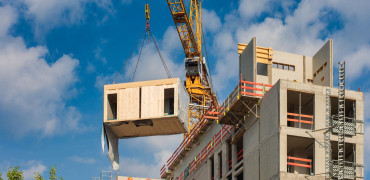The need to create new office space which helps firms limit rising energy costs and also appeals to employees who are increasingly inclined to work from home, is helping to sustain new office construction activity, particularly in London.
The growth in new refurbishment and fit-out projects as firms adapt their space to hybrid working has been a significant driver of new office projects in the Capital.
Recent data shows that the value of underlying (under £100 million in value) new office project approvals in London is on course to exceed £1,700 million in 2022, up from just over £1,400 million last year.
The upturn in office construction in the Capital has also been a key factor behind the increase in overall activity in the sector.
The latest Glenigan Construction Industry Forecast 2023-24 predicts that the total value of office starts will rise by 4% this year and a further 5% in 2023.
People spend more than 80% of their time indoors so the quality of the air inside a building really matters
Minimum standards
The drive for office buildings to be energy-efficient will be reinforced by the introduction of new standards from next April requiring any office space being let to reach a minimum EPC rating of band E and band B by 2030.
Employers may also feel a growing obligation to provide more comfortable surroundings for their staff. Recently updated guidance from the British Council for Offices recommends that office workers should each have up to 12 sq m of space, up from a previous density of 10 sq m per person.
The task of creating less-crowded space for office workers should generate some major opportunities for new construction contracts.
Indoor air matters too
England’s chief medical officer, Professor Chris Whitty, has called for offices and public buildings, including schools, supermarkets, and hospitals, to be regularly monitored for indoor air pollutants.
He believes that analysing the indoor air quality (IAQ) of many buildings should be made “standard practice” and that more investment is needed to tackle the problem in homes. He also called for investment in creating “indoor emission inventories” as part of a “roadmap to cleaner indoor air.”
This follows his 2022 annual report where he wrote that IAQ should be made a priority as it was becoming “an increasing proportion of the overall problem” with progress being made on tackling outdoor pollution.
He also pointed out that most people in developed countries spent more than 80% of their time indoors.
He added that IAQ was a complex problem because it varies dramatically from one building to another. He said the level of volatile organic compounds (VOCs) can differ by a factor of 1,000 in identical houses on the same street, because of different occupant behaviour or ventilation systems.
Addressing the problem
BESA’s Nathan Wood said detailed monitoring was a vital first step on the road to producing a more targeted IAQ strategy, adding that the technology was already widely available, affordable, and becoming increasingly accurate.
“The pandemic drew attention to the link between poor ventilation and the transmission of diseases around buildings – this accelerated the adoption of IAQ monitoring,” said Wood, who is chair of the Association’s Health & Well-being in Buildings group.
“We are now well placed to assess the scale and nature of the challenge, including analysing the cocktail of contaminants that can lead to indoor air being many times more polluted than the outdoors. However, showing someone that they have a problem is only the start. They must then be shown how to address the problem through competent professional advice and the use of proven solutions.”
Free guidance
BESA is also supporting the proposed Clean Air (Human Rights) Bill which is currently progressing through Parliament and would introduce specific responsibilities for building operators to meet IAQ targets in line with WHO guidance.
The Bill, which is also known as Ella’s Law in memory of Ella Kissi-Debrah, who died 10 years ago this month from a severe asthma attack triggered by air pollution, is being spearheaded by Ella’s mother Rosamund who has become a prominent air quality campaigner.
Nathan and Ros provide the opening words of the Beginners Guide to Indoor Air Quality that we produced in collaboration with BESA.
Following this, BESA produced a more technical guide demonstrating ‘Good Practice For Indoor Air Quality for Health & Well-being’, which is available to download here:
The third publication in the series is known as the BASH Guide (Buildings As Safe Havens) and is designed to offer a step-by-step guide to building owners and includes detailed questions that they should ask their ventilation suppliers. This is also available to download for free from the BESA site.
Paul Groves is editor of Specification magazine



